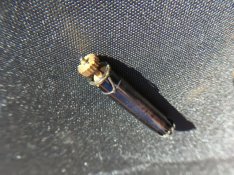So I found a Zenit E (m42 version) with a Helios 44-2 at a flea market today. It needed some tensioning of the curtain springs but otherwise was in good shape, working meter and everything, and it was half off at 15 dollars, so I bought it. When I got home I fixed the problem with one screwdriver and a pair of tiny needlenose, and it's firing great at all speeds now.
It's the first E I've ever seen, and I was surprised when I first examined it to find that it obviously wasn't the rickety third-world toy camera I'd been lead to believe. In most ways, it feels quite similar (though larger) to my other Zenit, a domestic-market Zenit S that I bought from Russia, including very, very crisp action of the shutter and an excellent balance in the hand.
Oddly, someone amateurishly engraved "7/9/55" in the baseplate of the E, which aside from being 65 years and ONE DAY ago (a bit of a coincidence, I'd say), assuming that's in American date order, is a good 11 years before the camera was manufactured in 1967! I would have to assume that either it's not a date, or that it's some important anniversary that the poor photographer could not for the life of him remember... odd that he didn't have paper, though...
So being as both of the Zenits I've handled have been excellent little cameras that run great despite at this point being in their fifties, I have to ask: is this unusual? The E series in particular have such a bad reputation as erratic or easy-breaking claptraps. Have I just gotten two unusually good Zenits? Or is it just anti-Soviet sentiment, or something else? I mean, the E is definitely basic for its time, but still exceedingly usable, and the Zenit S was definitely up to par with most of its contemporaries in the early days of the 35mm SLR... and they're all based on Leica II shutters! I just don't get it.
It's the first E I've ever seen, and I was surprised when I first examined it to find that it obviously wasn't the rickety third-world toy camera I'd been lead to believe. In most ways, it feels quite similar (though larger) to my other Zenit, a domestic-market Zenit S that I bought from Russia, including very, very crisp action of the shutter and an excellent balance in the hand.
Oddly, someone amateurishly engraved "7/9/55" in the baseplate of the E, which aside from being 65 years and ONE DAY ago (a bit of a coincidence, I'd say), assuming that's in American date order, is a good 11 years before the camera was manufactured in 1967! I would have to assume that either it's not a date, or that it's some important anniversary that the poor photographer could not for the life of him remember... odd that he didn't have paper, though...
So being as both of the Zenits I've handled have been excellent little cameras that run great despite at this point being in their fifties, I have to ask: is this unusual? The E series in particular have such a bad reputation as erratic or easy-breaking claptraps. Have I just gotten two unusually good Zenits? Or is it just anti-Soviet sentiment, or something else? I mean, the E is definitely basic for its time, but still exceedingly usable, and the Zenit S was definitely up to par with most of its contemporaries in the early days of the 35mm SLR... and they're all based on Leica II shutters! I just don't get it.











